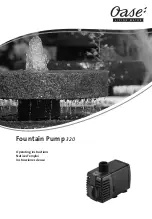
4
9
Note: 1. Long extension leads should be avoided as they often have insufficient
current carrying capacity to run electric motors, hence they can cause
substantial voltage drop and operating problems.
2. Minimum voltage at the electric motor must not fall below 216.
3. If the electrical fittings in your country make it necessary to remove the
plug from the lead fixed to the motor care should be taken to ensure
that the earth conductor green/yellow in the lead is properly connected
to a good earth. This work must only be undertaken by an authorised
electrician.
Three Phase
Some HM models are also available as 3 phase
model for 50Hz, nominal 415volt power supply. A
recommended wiring diagram can be found inside the
capacitor cover (see figure one below). Three phase
units must be wired in by an authorised electrician in
conjunction with a contactor which has “quicktrip” (M10)
overloads set at nameplate current.
Davey recommend the use of overloads which
also have the ability to detect “single phasing”
or “dropped phase” conditions in the power
supply.
Three phase models with output power of
below 1.4kW have been designed to provide
cable entry on the right hand side when viewed
from the non-drive or fan end of the motor. A
terminal block is provided under the capacitor
cover. Note: Three phase motors do not have capacitors fitted in the
capacitor cover.
Access to the terminal block is achieved by removal of the fan cowl
- see Figure A. Before prising the fan cowl ensure the retaining screw
has been removed.
The capacitor cover screw is then removed, allowing the cover to be
lifted (Figure B). Once the wiring has been completed and
checked, ensure the supply cable is run along the cable
access, the capacitor cover will clamp the supply cable once it
is re-installed. Replace the fan cowl and ensure the fan cowl
retaining screw is re-installed correctly.
Trouble Shooting Check List
MOTOR OPERATING BUT NOT PUMPING
1. Suction line and pump body not filled with water.
2. Leaking foot valve.
3. Air leaks in suction lines or suction pipe not under water.
4. Air trapped in suction lines (also possible with flooded suction) due to uneven
rise in piping (eliminate humps and hollows).
5. No water at source or water level too low.
6. Valve on suction or delivery lines closed.
MOTOR NOT RUNNING
1. Power not connected.
2. Supply voltage too low.
3. Overload tripped.
4. Motor not free to turn e.g. a blocked impeller.
5. Internal motor fault.
MOTOR RUNS FOR SOME TIME THEN STOPS - RESTARTS AUTOMATICALLY
AFTER SHORT TIME
Overload tripping in motor
- low voltage at motor terminals
- motor in direct sunshine or in “hot box”
- motor not free to turn (eg: blocked)
WARNING:
DO NOT RUN DRY.
DO NOT RUN WITH LOSS OF PRIME.
DO NOT PUMP WATER CONTAINING ABRASIVE MATERIALS.
Figure A
Figure B
WARNING: Automatic reset thermal overloads will allow the pump to restart
without warning. ALWAYS disconnect the pump motor from the electrical
supply before maintenance or repairs.
























